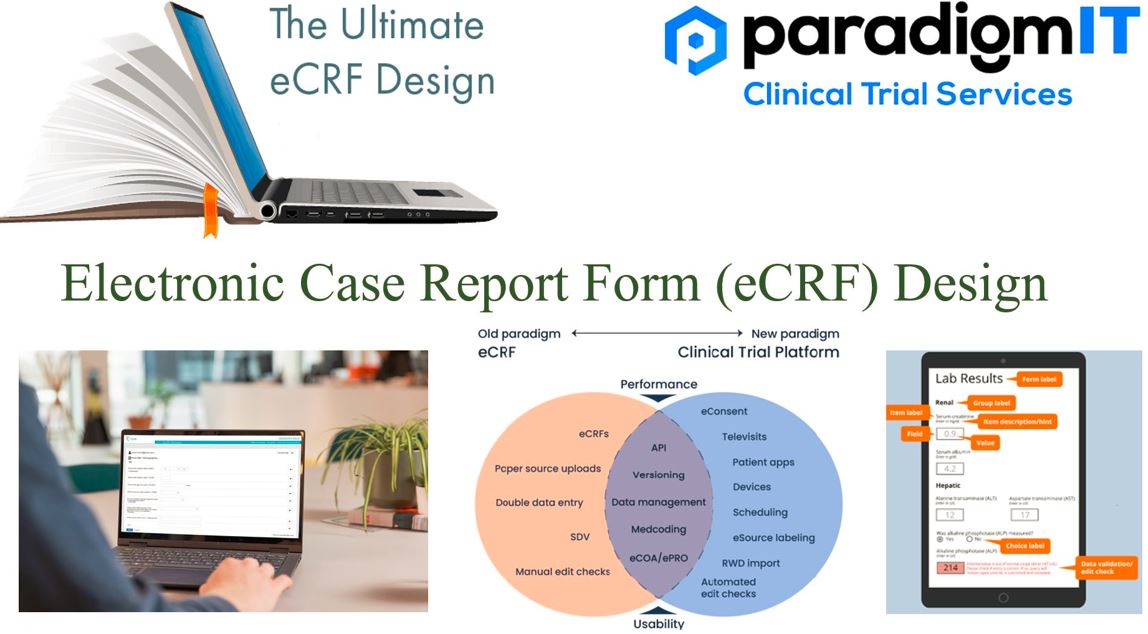With the advent of modern-day tools, clinical trials are steadily transitioning into a technology-driven process. One such aspect that is changing is the traditional data collection process. Paper case report forms used over the past many years were quite handy, but they are also cumbersome, time-consuming, and prone to errors. The electronic Case Report form (eCRF) overcomes these gaps and problems. That is why various medical devices and pharmaceutical companies have adopted them now.
What is an eCRF?
eCRF are digitized forms or e-questionnaires used for the data collection process in clinical trials. It serves as a tool for recording data related to the clinical study, typically in the context of pharmaceutical trials, medical device studies, or other types of medical research. The primary purpose of an eCRF is to gather structured and standardized data from participating study sites, healthcare providers, or patients. Clinical research analyses the data collected from eCRFs to make inferences from the clinical trials.
Advantages of eCRF?
- Promotes Remote data collection by authorized Personnel. Enhancing Patient centric trials by contributing data remotely by patients themselves (for example ePROs).
- Ease and secured data storage and data sharing (cloud-based)
- Real-time validation reduces the likelihood of data entry errors and inconsistencies, thereby improves the overall quality and accuracy of collected data.
- Maintains the traceability of data modifications that adds to the data integrity and accountability.
- Facilitates data integration with other systems, such as electronic health records (EHRs) or laboratory information systems.
- Provides real-time access to data for all stakeholders.
- Reduces cost and overall risk.
- Can comply with regulatory standards and be readily organized for regulatory inspections and audits.
How to Design an eCRF?
One should design the eCRF following the best practices to maximize its benefits. A high-quality eCRF is usually simple and not overly complicated. Below are certain principles that one should keep in mind while designing an eCRF,
- Study Objectives: Clearly understand the research questions and the data required to address them.
- Data Elements and Data Sources: List all data elements that need to collect, such as variables, measurements, information. Identify the sources of these data (such as clinical assessments, laboratory results, patient-reported outcomes, and medical records) and specify which data will be entered directly into eCRF and which will be imported.
- Data Dictionary: Comprehensive data dictionary been structured that defines each data element, including its name, description, data type (e.g., text, date, numeric), acceptable values, and any validation rules.
- Designing the eCRF Forms:
- Data Clarity and Context: To eliminate uncertainty, one should avoid unnecessary questions and open ended questions those can create ambiguity. Also, all the questions in the eCRF must be within the context of the investigation.
- Quantifiable and Relevant data: To make it easy to quantify, one needs to prefer pre-defined over free text. It reduces the need for data cleaning at a later stage. Also, one should ensure that the inputs received would be directly relevant to the study endpoints.
- Settings on Mandatory Fields: When the questionnaire has non-mandatory fields, it has missed inputs and difficulty comparing the data sets. Hence, one needs to set all the fields mandatory and provide options such as “not applicable” or “don’t know”.
- Validation Rules: Data validation rules to be implemented to ensure data quality and consistency. Examples include range checks, date format validation, and logic checks between related fields.
- Data Monitoring and Quality Assurance: Data monitoring and quality assurance processes been applied to review and validate the collected data regularly.
- Data Lock and Archiving: Once data collection is complete, lock the database to prevent further changes. Archive the eCRF data securely for future reference and audits.
Standardization of eCRF forms:
Standardization is a crucial aspect of eCRF design, especially in multi-centre clinical trials or research studies involving multiple sites or organizations. Standardization ensures consistency, comparability, and data quality across different data collection points. Here are some key considerations for standardizing eCRF forms:
- Use Common Data Elements (CDEs)
- Adopt Industry Standards
- Standardized Data Definitions
- Standardized Code Lists
- Standardized Data Collection Procedures
- Consistent Data Validation Rules
- Standardized Case Report Form Layout
- Use of Metadata
In conclusion, the design of Electronic Case Report Forms (eCRFs) is a pivotal aspect of clinical research and data collection. A well-designed eCRF system offers numerous benefits, including enhanced data accuracy, improved data quality control, increased efficiency, and streamlined data management. It promotes compliance with regulatory standards and facilitates data sharing and analysis.
For more information –
Visit our website – www.paradigmit.com
Or you can write us at ask@paradigmit.com
Follow us for more – https://www.linkedin.com/company/paradigmittechnologyservices/?viewAsMember=true


